|
The history of the Grout automobile and the family isn’t in any one book, yet. All of this information I’ve collected from sources like original motor journals, vintage car club news letters, local news papers, online searches, and the helpful Walter Pollard. There are quite a few discrepancies in facts collected like were there 3 or up to 6 brothers? I’ve done my best to leave the conjecture to what lead to the company’s demise. What would eventually become the Grout Brothers Automobile Company was established in Orange, MA, USA in 1896. Fred, the eldest of the brothers, was the mechanically minded of the brothers and with a 3 man team, built an opposed cylinder internal combustion auto in 1896. His brothers Karl and Charles joined the effort, and they made about a dozen cars between 1896 and 1898. He switched to designing steam wagons in 1898 after his I.C. vehicles proved to be too heavy for the power produced, and the carburetors were prone to fire. Their efforts finally proved enough for their dad, William L. Grout, to join, help organize, and expand the company. The father funded the brother’s endeavors with money made chiefly from his New Home sewing machine (over a million sold annually in the 1890’s), as W.L. Grout was quite industrious, a multi-patent holder, and a friend/rival of Mr. White (also of sewing machine and automobile production). It was his industry that brought the family to Orange, MA as the town was well supplied and situated for manufacturing. The first purpose built factory for automobiles was opened for the Grout Brothers in 1900- it still stands and is a tire warehouse. Speed trials, fuel economy trials, hill climbs, and auto shows garnered the Grout autos great esteem with many 1st place prizes in the states 1903 race with the Stanley Turtle, a bent rod sent them home and the racer was disassembled. Grout produced fire engines and work trucks they called steam wagons as well as automobiles for pleasure. The driver of the steam wagon sat on the boiler, with the engine placed midway back and wheels driven by countershaft chains. A 1904 Grout Steam wagon is the oldest known truck pictured to haul an automobile in the USA. Grouts used their wagons to deliver their vehicles to nearby buyers or to the train, keeping their delivered product perfectly clean. By 1905, 125 men were employed and continued to produce “thousands” of Grout Automobiles if their ads are to be believed. Thomas Edison was one of the first to purchase their new gas models after a tour of the expanded factory August of 1905. 1903 was the last year of tiller steer, and 1906 was the last year for steam power. There are no records surviving of how many cars the Grouts actually produced before their closure, but there is remaining hearsay of how the company met its demise. Family funding means family expectations and the younger brothers held onto Fred’s coat tails, becoming less and less helpful and more about having a good time as the company progressed successfully. A car went for a river swim during a delivery. A unnamed Grout brother in charge of delivery stopped for a drink at the pub, filled with liquid courage, he took a lady for a quick spin and went too quick for the turn before the river. Perhaps that’s why they implemented the steam wagon delivery. Charles and Karl made the family drama more public, going to court in 1907 against their 73 year old father who was trying to take management control, he didn’t like how the company was being managed and they claimed his second wife wanted more money and was taking advantage of his failing mind. The brothers were appalled when they each were willed $5 after their millionaire father’s 1908 death. Their stepmother refused to “fund their playtime” and pulled out all the remaining financial support that their father left standing. The brothers left the company and town, and the company met a steep decline, falling into receivership and multiple changing of hands before finally folding in 1912. The family sold any remaining holdings with the factory buildings auction in 1913, and the last mention of a Grout automobile being produced is 1915. The brothers had short lives, possibly due to tuberculosis. Fred died in New Mexico in 1909. Tilly, a 1903 model J drop front is an example of the Grout Brothers’ abilities during their most productive years 1900-1904. The earliest mention I have found of our car is a 1941 Wolfeboro NH article about three local young men collecting and restoring old vehicles. Harry Hopewell had what he then believed to be a 1905 Grout steamer in storage in his Newton MA home. The only clue we have of Tilly’s original owner somewhere in Maine is the story given at the discovery purchase. After a particularly bad day of learning to operate her new to her car, the lady of the house was on the last leg of the drive and ran over her neighbor’s cat. Distraught, she parked the car at the back of the shed, where it sat, behind a wood pile, until Harry bought it. 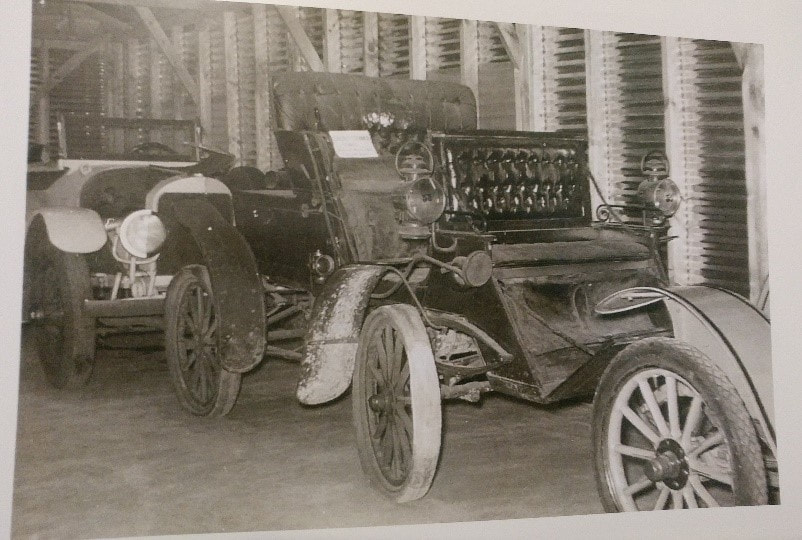 After the war, Tilly was placed on display in Mr. Glen Gould’s Shirley Auto Museum where it sat, a bunkmate to a 1904 Grout that participated in the 2010 LBVCR, unrestored and un-operational until 1967. Tilly was part of a group lot my father-in-law, Frank Cooke, purchased from Harry who by then had decided that the year was more likely a 03 or 04. The license plate numbers inscribed on the lanterns are assumed to be the culprit of the 05 dating as Maine issued plates starting in 05. That’s a whole new rabbit hole to explore as the scribbled numbers in our oldest known photo are a 33? 55? 88? The only combination that works with the license registry is 85, to a Theodore Davis of Portland with a 4hp Grout. Satellite map imaging show his listed address is now apartment buildings, so I can’t confirm the story by building placements. Further research is due. 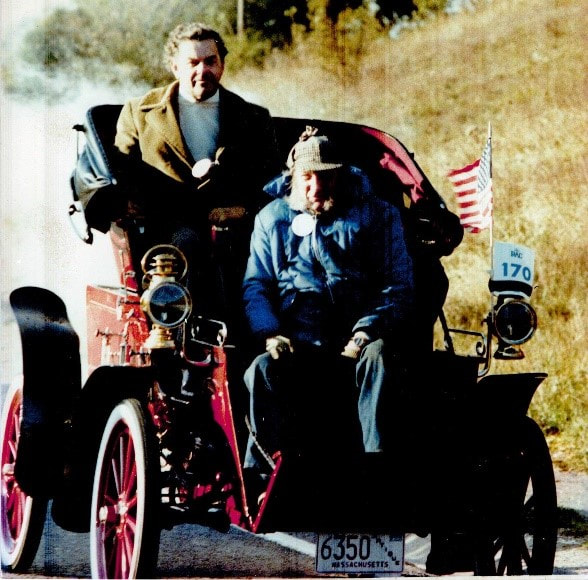 Frank got the car operational but not restored in any way and had it tooling about locally before deciding to ship it over for the London to Brighton run in 1979. It was a failed attempt stopped at Worthing with further injury as the bypass was closed during towing, causing great engine damage being pumped full of water. The Brighton and Hove Engineerium took custody of Tilly and not only repaired but repainted it, leading to a successful 1980 and 81 L to B run. The 81 souvenir program has a cute note. “ Grout- American steam cars, Frank Cooke of North Brookfield, Mass. (USA) has taken part in the run these past two years with is 1903 car but E. Frank Taliaferro, from San Diego California, on the West Coast is in for a shock when he arrives with his 1901 Grout for the first time. On his entry for he stated, “Only Grout in running condition in existence (to our knowledge)”. Mr. Taliaferro me Mr. Cooke...(no’s 88 and 185)” Mr. Taliaferro had a 7hp surrey. Tilly came back to the states and took the long-term mantle of the only reliably running Grout in New England until the early 2000s when Frank and his son Billings (Bill) decided to upgrade the original burner and replace the boiler as the car simply couldn’t produce enough steam for continuous driving. Frank passed in 2005, and Tilly went into storage incomplete. 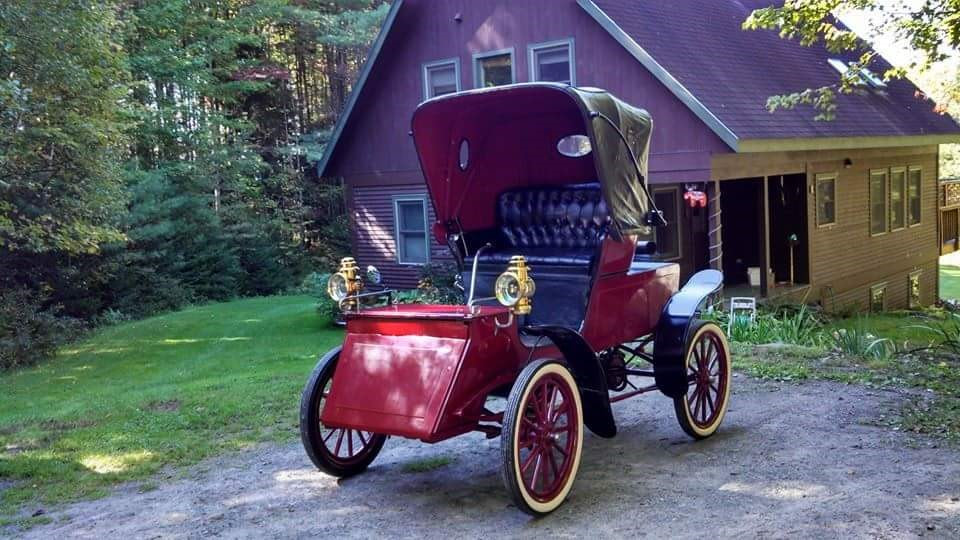 Tilly was brought out of storage with an invite to the 2013 Boston Cup as part of their Made in Massachusetts highlight. It received the people’s choice award; Bill received the gumption to get it running again. Storage was not friendly to Tilly. The original wood body had developed a sway back and several structural cracks that were unsafe at any speed, forget the weight of a bigger burner and boiler. Starting in 2016, M.S. Herman & Co did the body dismantle and restoration, while Bourdon Boiler Works built a new copper water tank to go along with the previously made burner and boiler, and Rempco rebuilt a newly acquired Grout engine replacing the small engine (not Grout) used for the 1979 repair. Stutzman Wheel shop made four new wheels. Randy Beaudoin of North Country Signs gave a color match new body and wheel paint and Kenny Jacobs did the gold-leaf and pinstripes. The seats are still in good condition and received conditioner only, but moths got to the flannel lining of the top. Mike Lemier of Richmond Upholstery repaired the lining and reset the glass windows. 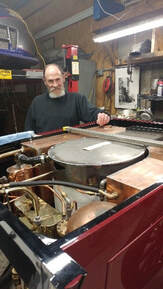 The rest of the reassembly happened at home, and I assisted where possible. Trying to improve the brake system proved problematic. Tilly had only one brake drum and shoe on the differential as originally constructed. The construction of the differential offered the opportunity for a second brake setup. Frank added the necessary components to have a shoe on both sides of the chain sprocket. He used a cable and pully balance system from the brake pedal as the original brake rod path passes above the chain sprocket on the engine and is tight for two rods. Bill kept the two shoes and upgraded the cable system to two rods with a balance bar near the brake pedal to balance the pull on the two shoes. This still just slows us down, not stop. We’re still playing with brake lining options, hydraulics are a future possibility. The other brake project is to make a parking brake, as the hills and mountains of Vermont have few flat spaces.  A pilot tank was added, as the Grout originally ran a single fuel tank with both burner and pilot running on gasoline. It was mounted beneath the front passenger seat, out of sight. The new Stanley style pilot is now fueled by coleman fuel, the original pilot was comparable to a miniature blow torch and lit “with a single match”. The first firing was in May of this year. Growing pains started not long after, as on the second run we (with me driving) plugged our boiler sight gauge with mud we’re still blowing out of the boiler and had a small scorch in our driveway. Time sitting wasn’t good for the inside of the boiler, we still have no idea what actually caused the mud to build up. But Tilly likes to sing, and we’ve been back out on the road a couple more times. Definitely miss those club meets, gets us out of the house and our cars on the road. And we’re currently installing a second boiler gauge of David Nergaard’s design. It’s similar to a Bristol Derr water gauge, so a bit higher tech but also camouflageable, it won’t stick out like a sore thumb. The sight glass only gave us the bottom third of the boiler, this new gauge will give us readings from empty to full. 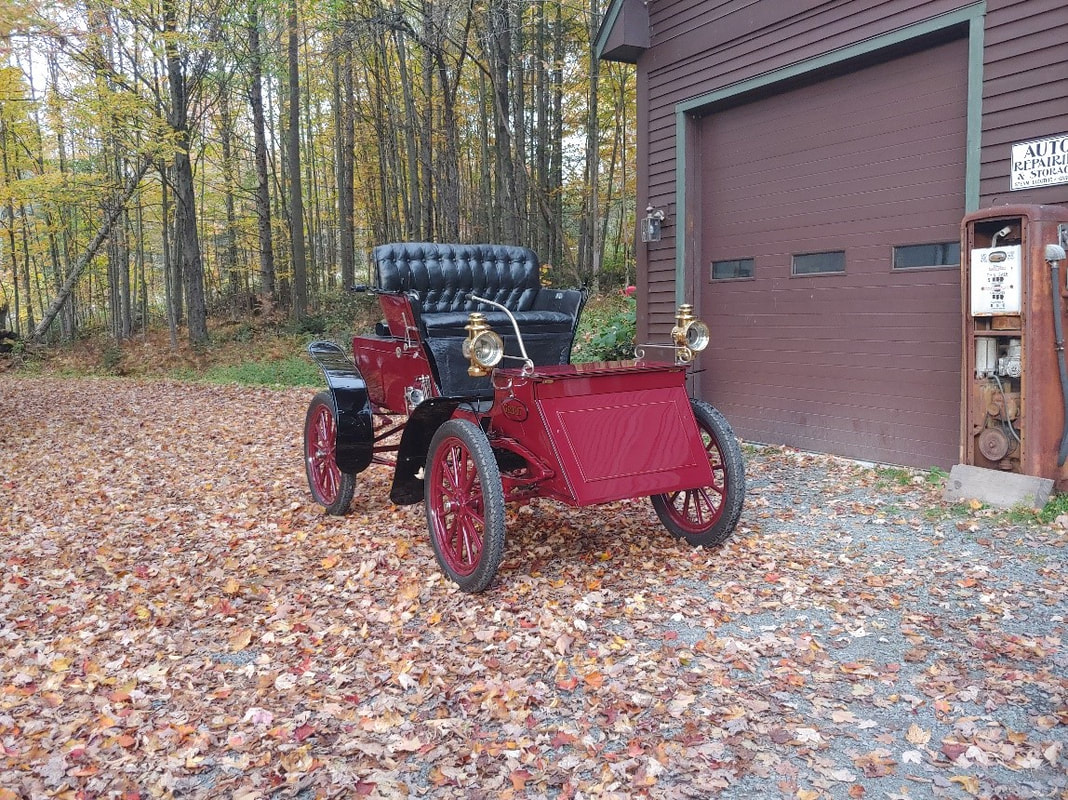 The top never had a boot for it’s down position, Frank lashed it down with straps for open trailer towing. This is my winter project, to build a boot or two for Tilly. I’ve got enough material, there might be a bag for onboard tools as well. 2020 was supposed to be Tilly’s grand debut at the Eastern steam tour, which we were also hosting in Tilly’s old stomping grounds in central Massachusetts. That has been optimistically rescheduled to June 2021 and we hope to see our small and large horsepower friends again. We also want to spread the word that the Orange Historical Society would like to know who else has a Grout, Mr. Pollard is the lead Grout historian there. There are currently about 30 known steam-powered Grouts in the world and no internal combustion Grouts. Mr. Pollard is writing a book about the Grouts and their company, spending the last 25 years on research. He can be contacted directly at [email protected]. Sarah Moon
1 Comment
Joshua Grout
9/6/2023 02:48:16 pm
Cool to see interest in my Family’s old business
Reply
Leave a Reply. |
Archives
December 2022
Categories
All
|
|
|
Steam Car Network functions as a resource for all steam car and steam bike enthusiasts. The website is constantly updated with articles, events, and informative posts to keep the community alive and growing. Feel free to contact us if you have any questions or concerns at the email address below and we will promptly reply.
[email protected] |

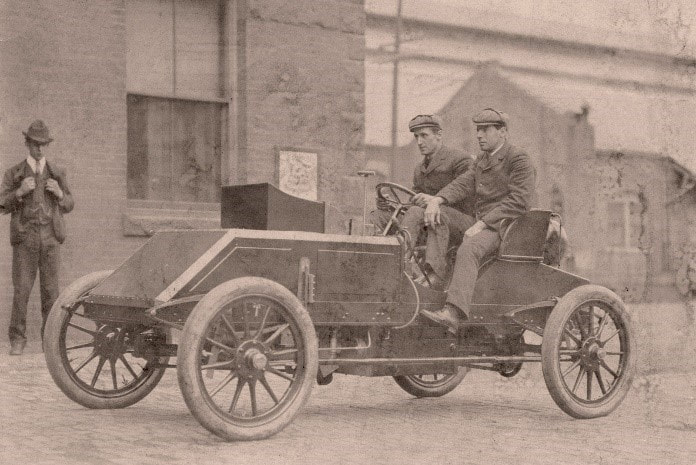
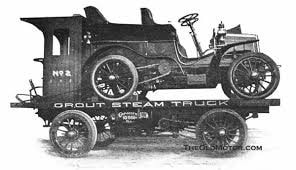
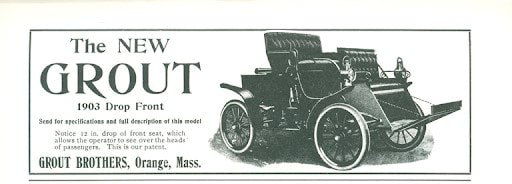

 RSS Feed
RSS Feed
